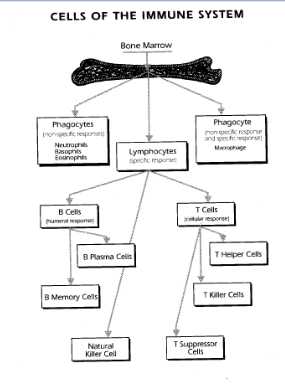Over the next few blogs, I am going to give you a tour of immune system quoted out my book, “The Immune System Handbook”. My hope is that when you get acquainted with how powerful your immune system is, you will support it and allow it to do its job.
Let’s begin our tour by visiting some bone marrow. As mentioned before, bone marrow is the origin of all immune cells. B cells complete their maturation in the bone marrow.
T cells, on the other hand, migrate to the thymus, which we will now tour. The thymus is a grayish organ with two lobes, sitting behind the breastbone, near the heart. It is part of the endocrine system. Incidentally, some writers suggest there is clinical evidence that production of T cells can be stimulated by tapping the breastbone. This stimulates thymus hormones, which in turn stimulates T-cell production.
We see that the thymus is a training center for inexperienced T cells. The thymus produces several hormones which are used to train T cells. They are trained to distinguish “self” cells from “non self” cells; T cells that would react against “self” markers are abolished. Here the T cells multiply and reach maturity. This training is particularly essential to the development of the immune response in newborns.
Let us follow some B cells and T cells as they exit the bone marrow and thymus. Some of these cells gather in immune organs like the spleen or tonsils or they stay in the lymph nodes. Others travel widely and continuously throughout the body via the blood circulation and the lymph system.
Lymph is a clear and colorless fluid that is collected from tissue in all parts of the body. It is then returned to the blood by way of the lymphatic system. Lymph contains many different proteins, salts, organic substances and water. The lymph system has ducts and tissues which convey the lymph fluid from the body’s tissues to the bloodstream. Unlike our blood circulation system, which has a pump (the heart) and valves in the veins to ensure blood circulation, the lymph system depends entirely on muscular activity and deep breathing to keep the lymph moving.
As we travel through this system, we see that it includes capillaries, nodes, vessels and ducts. The lymph acts as a cleanser by collecting harmful substances from these tissue spaces and transporting them across the thin walls of tiny lymphatic vessels. The vessels transport the mix to lymph nodes, where foreign matter, debris, unwanted microorganisms and dust particles are filtered out. Anything unwanted is presented to immune cells.
The bean shaped lymph nodes are located along the lymphatic routes with clusters in the neck, armpits, abdomen, and groin. During flu, a cold or after a tooth extraction, you may have noticed swelling in some of these lymph areas evidence that your immune system was hard at work protecting you.
Each lymph node contains specialized compartments. Each compartment has platoons of B cells, T cells and other cells capable of trapping the invader and presenting it to T cells. Once their job is done, the lymph is clear. Then it makes its way to the base of the neck where large lymphatic vessels funnel into the thoracic duct.
The thoracic duct empties its contents into the bloodstream. Once in the bloodstream, the lymphocytes and other assorted immune cells are transported to tissues throughout the body. They patrol everywhere for foreign invaders, then gradually drift back into the lymphatic vessels, and begin the cycle again.
As we complete our tour, we find another location where many T and B cells gather, in the spleen. It is a fist sized organ at the upper left of the abdomen. Here, many elements of invading organisms are filtered out of the circulating blood system. They are presented to the immune system, allowing it to respond in very specific ways that will provide protection against disease or infection.
The spleen also screens out ineffective or exhausted blood cells of the immune system. It contains two main types of tissue. The red pulp, where worn out blood cells are disposed; and the white pulp, which contains lymphoid tissue. Like the lymph nodes, the spleen’s lymphoid tissue is subdivided into compartments that specialize in a variety of immune cells. Microorganisms carried by the blood into the red pulp become trapped by the immune cells known as macrophages. (Although people can live without a spleen, persons whose spleens have been damaged by trauma or disease are highly susceptible to infection).
We will continue this tour in the next blog. If you have any questions or need any immune support, please reach out.
To your good health.
Charlene

